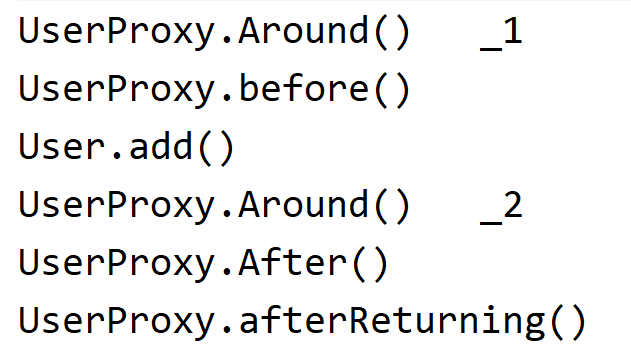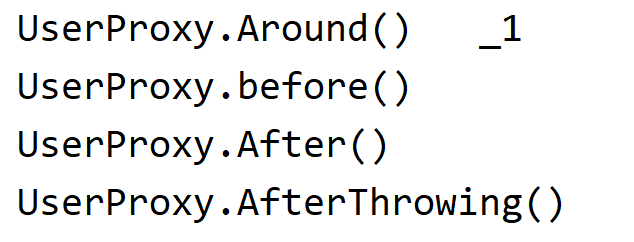1 原理
JDK动态代理
- 通过 java.lang.reflect.Proxy类 的 newProxyInstance方法 创建代理类。
- newProxyInstance方法:

1. 参数一:类加载器
1. 参数二:所增强方法所在的类,这个类实现的接口,支持多个接口
1. 参数三:实现InvocationHandle接口,重写invoke方法来添加新的功能
接口:
1
2
3
4
| public interface UserDao {
public int add(int a, int b);
public int multi(int a, int b);
}
|
实现类:
1
2
3
4
5
6
7
8
9
10
11
| public class UserDaoImpl implements UserDao {
@Override
public int add(int a, int b) {
return a+b;
}
@Override
public int multi(int a, int b) {
return a*b;
}
}
|
增强类
1
2
3
4
5
6
7
8
9
10
11
12
13
14
15
16
17
18
19
20
| public class UserDaoProxy implements InvocationHandler {
Object obj;
public UserDaoProxy(Object obj){
this.obj = obj;
}
@Override
public Object invoke(Object proxy, Method method, Object[] args) throws Throwable {
System.out.println("进入" + method.getName() + "方法,这是新增的代码,参数有" + Arrays.toString(args));
Object invoke = method.invoke(obj, args);
System.out.println("方法原先的内容执行完了");
return invoke;
}
}
|
测试:
1
2
3
4
5
6
7
8
9
10
11
12
13
14
15
16
17
18
19
| public class Main {
@Test
public void test1(){
Class[] interfaces = {UserDao.class};
UserDao userDao = new UserDaoImpl();
UserDao userDaoProxy = (UserDao) Proxy.newProxyInstance(Main.class.getClassLoader(), interfaces, new UserDaoProxy(userDao));
int result = userDaoProxy.add(1, 2);
System.out.println(result);
}
}
|

CGLIB动态代理
目标类
1
2
3
4
5
| public class TargetClass {
public void doSomething() {
System.out.println("目标方法");
}
}
|
实现MethodInterceptor接口
1
2
3
4
5
6
7
8
9
10
11
12
13
| import net.sf.cglib.proxy.MethodInterceptor;
import net.sf.cglib.proxy.MethodProxy;
import java.lang.reflect.Method;
public class CustomMethodInterceptor implements MethodInterceptor {
@Override
public Object intercept(Object obj, Method method, Object[] args, MethodProxy proxy) throws Throwable {
System.out.println("执行目标方法之前");
Object result = proxy.invokeSuper(obj, args);
System.out.println("执行目标方法之后");
return result;
}
}
|
测试
1
2
3
4
5
6
7
8
9
10
11
12
| import net.sf.cglib.proxy.Enhancer;
public class CglibDynamicProxyDemo {
public static void main(String[] args) {
Enhancer enhancer = new Enhancer();
enhancer.setSuperclass(TargetClass.class);
enhancer.setCallback(new CustomMethodInterceptor());
TargetClass proxy = (TargetClass) enhancer.create();
proxy.doSomething();
}
}
|
结果
2 基于AspectJ实现AOP操作
AOP相关术语
- 连接点:类中可以被增强的方法,称为连接点。
- 切入点:实际被增强的方法,称为切入点。
- 通知:增强的那一部分逻辑代码。通知有多种类型:
- 前置通知:增强部分代码在原代码前面。
- 后置通知:增强部分代码在原代码后面。
- 环绕通知:增强部分代码既有在原代码前面,也有在原代码后面。
- 异常通知:原代码发生异常后才会执行。
- 最终通知:类似与finally那一部分
- 切面:指把通知应用到切入点这一个动作。
切入点表达式
语法:execution([权限修饰符] [返回类型] [类全路径] [方法名称] [参数列表])
对 com.atguigu.dao.BookDao 类里面的 add 进行增强
1
| execution(* com.auguigu.dao.BookDao.add(..))
|
对 com.atguigu.dao.BookDao 类里面的所有的方法进行增强
1
| execution(* com.atguigu.dao.BookDao.*(..))
|
对 com.atguigu.dao 包里面所有类,类里面所有方法进行增强
1
| execution(* com.atguigu.dao.*.* (..))
|
基于注解实现AOP
1
2
3
4
5
6
| @Component
public class User {
public void add(){
System.out.println("User.add()");
}
}
|
1
2
3
4
5
6
7
8
9
10
11
12
13
14
15
16
17
18
19
20
21
22
23
24
25
26
27
28
29
30
31
32
33
34
35
36
37
38
39
| @Component
@Aspect
public class UserProxy {
@Before(value="execution(* com.oymn.spring5.User.add(..))")
public void before(){
System.out.println("UserProxy.before()");
}
@AfterReturning(value="execution(* com.oymn.spring5.User.add(..))")
public void afterReturning(){
System.out.println("UserProxy.afterReturning()");
}
@After(value="execution(* com.oymn.spring5.User.add(..))")
public void After(){
System.out.println("UserProxy.After()");
}
@AfterThrowing(value="execution(* com.oymn.spring5.User.add(..))")
public void AfterThrowing(){
System.out.println("UserProxy.AfterThrowing()");
}
@Around(value="execution(* com.oymn.spring5.User.add(..))")
public void Around(ProceedingJoinPoint proceedingJoinPoint) throws Throwable{
System.out.println("UserProxy.Around() _1");
proceedingJoinPoint.proceed();
System.out.println("UserProxy.Around() _2");
}
}
|
配置类
1
2
3
4
5
6
| @Configuration
@ComponentScan(basePackages = "com.oymn.spring5")
@EnableAspectJAutoProxy(proxyTargetClass = true)
public class Config {
}
|
测试
1
2
3
4
5
6
| @Test
public void test2(){
ClassPathXmlApplicationContext context = new ClassPathXmlApplicationContext("bean1.xml");
User user = context.getBean("user", User.class);
user.add();
}
|
输出

异常
1
2
3
4
| public void add(){
int i = 1/0;
System.out.println("User.add()");
}
|

对于上面的例子,有很多通知的切入点都是相同的方法,因此,可以将该切入点进行抽取:通过@Pointcut注解
1
2
3
4
5
6
7
8
9
10
| @Pointcut(value="execution(* com.oymn.spring5.User.add(..))")
public void pointDemo(){
}
@Before(value="pointDemo()")
public void before(){
System.out.println("UserProxy.before()");
}
|
优先级
当有多个增强类对同一方法进行增强时,可以通过**@Order(数字值)来设置增强类的优先级,数字越小优先级越高。**
1
2
3
4
| @Component
@Aspect
@Order(1)
public class PersonProxy
|



